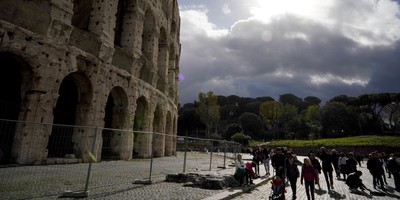WASHINGTON -- In 1931, during the liquidation of millions of kulaks, Josef Stalin granted an audience to George Bernard Shaw and Lady Nancy Astor. Astor bluntly asked: "When are you going to stop killing people?" To which Stalin replied: "When it is no longer necessary."
Stalin found it necessary to the end of his days. He was a hardworking dictator, often in the office 16 hours a day. It takes considerable effort to cause the deaths of perhaps 20 million human beings. And death was Stalin's primary political instrument.
Statues and busts of Stalin were once mass-produced in Russia as icons of a political cult. Few can now be found on public display outside his hometown of Gori, Georgia, where some people remain perversely proud of a local boy made bad. But a newly cast memorial bust of Stalin now stands at the National D-Day Memorial in Bedford, Va., accompanying sculptures of Franklin D. Roosevelt, Charles de Gaulle and Winston Churchill. A plaque recounts Stalin's practice of "eliminating" his opponents. But Stalin would doubtlessly be pleased by the likeness and its setting.
Others are not so pleased. The Bedford County Board of Supervisors, the local congressman and the Victims of Communism Memorial Foundation have called for the bust's removal.
Americans have sometimes viewed Stalin with more ambivalence than, say, Adolf Hitler. For a period during World War II, "Uncle Joe" was an ally. Roosevelt sent about $11 billion worth of war materiel to Stalin under Lend-Lease.
But Stalin had previously been an ally of Hitler as well, both inspiring and admiring Nazi methods. Following Hitler's purge in 1934 known as the "night of the long knives," Stalin told a meeting of the Politburo: "Some fellow that Hitler. Knows how to treat his political opponents."
Recommended
One reason that Stalin has sometimes gotten more favorable treatment than Hitler is the conviction, mainly found on the American left, that communism is less evil than fascism. Stalin may have been a monster, but at least he was not a genocidal racist. His methods were barbaric; but the goals of Soviet socialism -- economic equality and justice -- were nobler than National Socialism.
This attitude once turned some Western leftists into Stalin apologists. The durable belief in communist good intentions led, according to historian Robert Conquest, to "feminists applauding women who were bowed down by hundredweights of coal, Quakers applauding tank parades."
But Stalin authored racial atrocities of his own. Historian Andrew Roberts notes: "Stalin also committed seven major acts of racial genocide, against the Ukrainians in 1930-32, the Poles, Balts, Moldavians and Bessarabians in 1939-41 and 1944-45, the Volga Germans in 1941, the Crimean Tatars in 1943, the Chechens and the Inguches in 1944."
Stalin and Hitler were moral equals in nearly every respect -- the slave labor camps, the mass graves, the night arrests, the sadistic and sycophantic circle of enablers. Stalin added forced famine -- in which millions of lives were taken like a scythe takes wheat -- along with show trials and purges. Stalin's lieutenants would act out for his entertainment the pleadings of old colleagues about to be executed. "The greatest delight," Stalin once said, "is to mark one's enemy, prepare everything, avenge oneself thoroughly, and then go to sleep."
The main difference between Hitler and Stalin is that one lost a war and ended with a bullet in his head. The other gets a bust at the National D-Day Memorial.
Officials at the Bedford memorial respond to the controversy with typical museum-speak about their "educational mission" to examine "global contexts and consequences" while being a "catalyst for serious discourse." The former president of the memorial compared criticism of the Stalin bust to criticism of a statue depicting FDR in a wheelchair.
It is extraordinary how people dedicated to the preservation of history can so effectively trivialize history by denying its emotional and moral content. How would a Pole whose father or grandfather was murdered in the Katyn Forest massacre be educated by walking past a memorial bust of Stalin? How is Russian sacrifice in World War II honored by the image of a man who treated Russia to endless, unnecessary sacrifice?
For most Americans who fought in World War II, it was not merely a historical event; it was a cause. They temporarily shared an alliance with Stalin, but they fought for principles he hated. His presence at their memorial is not educational; it is offensive.

























Join the conversation as a VIP Member